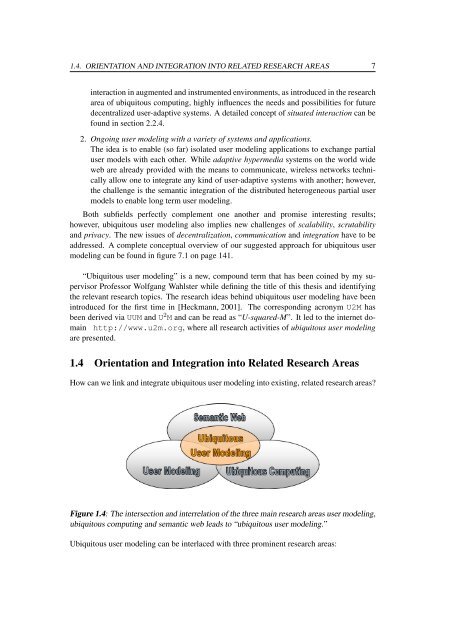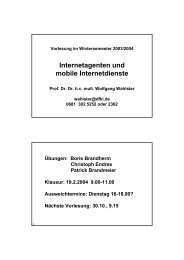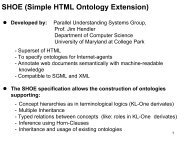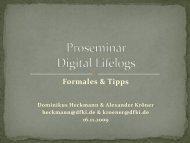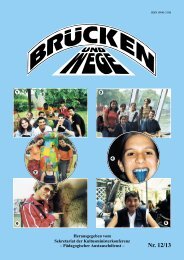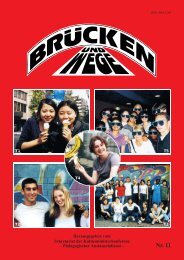- Page 1 and 2: Ubiquitous User Modeling Dissertati
- Page 3: Eidesstattliche Versicherung Hiermi
- Page 7 and 8: Acknowledgments This work has been
- Page 9: Kurzzusammenfassung Immer häufiger
- Page 12 and 13: xii
- Page 14 and 15: xiv werden. Zusätzlich wird das UR
- Page 16 and 17: xvi
- Page 18 and 19: xviii Contents 3.1.4 Deep Map User
- Page 20 and 21: xx Contents 7 User Model Integratio
- Page 22 and 23: xxii Contents B.2.2 UBISWORLD ONTOL
- Page 25 and 26: 1 1.1 Motivation MOTIVATION & OUTLI
- Page 27: 1.2. APPLICATION SCENARIO 5 as well
- Page 31 and 32: 1.5. MAIN RESEARCH QUESTIONS 9 We i
- Page 33 and 34: 1.6. ORGANIZATION OF THE THESIS 11
- Page 35 and 36: 2 BACKGROUND & BASIC CONCEPTS Infor
- Page 37 and 38: 2.1. INTRODUCTION TO USER MODELING
- Page 39 and 40: 2.1. INTRODUCTION TO USER MODELING
- Page 41 and 42: 2.2. INTRODUCTION TO UBIQUITOUS AND
- Page 43 and 44: 2.2. INTRODUCTION TO UBIQUITOUS AND
- Page 45 and 46: 2.2. INTRODUCTION TO UBIQUITOUS AND
- Page 47 and 48: 2.2. INTRODUCTION TO UBIQUITOUS AND
- Page 49 and 50: 2.3. INTRODUCTION TO THE SEMANTIC W
- Page 51 and 52: 2.3. INTRODUCTION TO THE SEMANTIC W
- Page 53 and 54: 2.3. INTRODUCTION TO THE SEMANTIC W
- Page 55 and 56: 3 3.1 Generic User Modeling Systems
- Page 57 and 58: 3.1. GENERIC USER MODELING SYSTEMS
- Page 59 and 60: 3.2. METADATA APPLICATIONS 37 Figur
- Page 61 and 62: 3.2. METADATA APPLICATIONS 39 3.2.2
- Page 63 and 64: 3.3. EXTERNAL ONTOLOGIES AND KNOWLE
- Page 65 and 66: 3.3. EXTERNAL ONTOLOGIES AND KNOWLE
- Page 67 and 68: 3.3. EXTERNAL ONTOLOGIES AND KNOWLE
- Page 69 and 70: 3.3. EXTERNAL ONTOLOGIES AND KNOWLE
- Page 71 and 72: 3.4. DESIGN DECISIONS AND GOALS 49
- Page 73: Part II Knowledge Representation an
- Page 76 and 77: 54 CHAPTER 4. SITUATIONAL STATEMENT
- Page 78 and 79:
56 CHAPTER 4. SITUATIONAL STATEMENT
- Page 80 and 81:
58 CHAPTER 4. SITUATIONAL STATEMENT
- Page 82 and 83:
60 CHAPTER 4. SITUATIONAL STATEMENT
- Page 84 and 85:
62 CHAPTER 4. SITUATIONAL STATEMENT
- Page 86 and 87:
64 CHAPTER 4. SITUATIONAL STATEMENT
- Page 88 and 89:
66 CHAPTER 4. SITUATIONAL STATEMENT
- Page 90 and 91:
68 CHAPTER 4. SITUATIONAL STATEMENT
- Page 92 and 93:
70 CHAPTER 4. SITUATIONAL STATEMENT
- Page 94 and 95:
72 CHAPTER 4. SITUATIONAL STATEMENT
- Page 96 and 97:
74 CHAPTER 4. SITUATIONAL STATEMENT
- Page 98 and 99:
76 CHAPTER 4. SITUATIONAL STATEMENT
- Page 100 and 101:
78 CHAPTER 4. SITUATIONAL STATEMENT
- Page 102 and 103:
80 CHAPTER 4. SITUATIONAL STATEMENT
- Page 104 and 105:
82 CHAPTER 5. USER MODEL ONTOLOGY &
- Page 106 and 107:
84 CHAPTER 5. USER MODEL ONTOLOGY &
- Page 108 and 109:
86 CHAPTER 5. USER MODEL ONTOLOGY &
- Page 110 and 111:
88 CHAPTER 5. USER MODEL ONTOLOGY &
- Page 112 and 113:
90 CHAPTER 5. USER MODEL ONTOLOGY &
- Page 114 and 115:
92 CHAPTER 5. USER MODEL ONTOLOGY &
- Page 116 and 117:
94 CHAPTER 5. USER MODEL ONTOLOGY &
- Page 118 and 119:
96 CHAPTER 5. USER MODEL ONTOLOGY &
- Page 120 and 121:
98 CHAPTER 5. USER MODEL ONTOLOGY &
- Page 122 and 123:
100 CHAPTER 5. USER MODEL ONTOLOGY
- Page 124 and 125:
102 CHAPTER 5. USER MODEL ONTOLOGY
- Page 126 and 127:
104 CHAPTER 5. USER MODEL ONTOLOGY
- Page 128 and 129:
106 CHAPTER 5. USER MODEL ONTOLOGY
- Page 130 and 131:
108 CHAPTER 5. USER MODEL ONTOLOGY
- Page 132 and 133:
110 CHAPTER 5. USER MODEL ONTOLOGY
- Page 134 and 135:
112 CHAPTER 5. USER MODEL ONTOLOGY
- Page 136 and 137:
114 CHAPTER 5. USER MODEL ONTOLOGY
- Page 138 and 139:
116 CHAPTER 5. USER MODEL ONTOLOGY
- Page 140 and 141:
118 CHAPTER 5. USER MODEL ONTOLOGY
- Page 142 and 143:
120 CHAPTER 6. SITUATION RETRIEVAL
- Page 144 and 145:
122 CHAPTER 6. SITUATION RETRIEVAL
- Page 146 and 147:
124 CHAPTER 6. SITUATION RETRIEVAL
- Page 148 and 149:
126 CHAPTER 6. SITUATION RETRIEVAL
- Page 150 and 151:
128 CHAPTER 6. SITUATION RETRIEVAL
- Page 152 and 153:
130 CHAPTER 6. SITUATION RETRIEVAL
- Page 154 and 155:
132 CHAPTER 6. SITUATION RETRIEVAL
- Page 156 and 157:
134 CHAPTER 6. SITUATION RETRIEVAL
- Page 158 and 159:
136 CHAPTER 6. SITUATION RETRIEVAL
- Page 160 and 161:
138 CHAPTER 6. SITUATION RETRIEVAL
- Page 162 and 163:
140 CHAPTER 6. SITUATION RETRIEVAL
- Page 164 and 165:
142 CHAPTER 7. USER MODEL INTEGRATI
- Page 166 and 167:
144 CHAPTER 7. USER MODEL INTEGRATI
- Page 168 and 169:
146 CHAPTER 7. USER MODEL INTEGRATI
- Page 170 and 171:
148 CHAPTER 7. USER MODEL INTEGRATI
- Page 172 and 173:
150 CHAPTER 7. USER MODEL INTEGRATI
- Page 174 and 175:
152 CHAPTER 7. USER MODEL INTEGRATI
- Page 177 and 178:
8 8.1 USERMODELSERVICE USER MODEL S
- Page 179 and 180:
8.1. USERMODELSERVICE 157 possible
- Page 181 and 182:
8.1. USERMODELSERVICE 159 listing 8
- Page 183 and 184:
8.2. USER INTERFACES FOR UBISWORLD
- Page 185 and 186:
8.3. USER INTERFACES FOR UBISLOCATI
- Page 187 and 188:
8.3. USER INTERFACES FOR UBISLOCATI
- Page 189 and 190:
8.4. USER INTERFACES FOR USER MODEL
- Page 191 and 192:
8.4. USER INTERFACES FOR USER MODEL
- Page 193 and 194:
8.4. USER INTERFACES FOR USER MODEL
- Page 195 and 196:
8.4. USER INTERFACES FOR USER MODEL
- Page 197 and 198:
9 APPLICATIONS & TESTING This chapt
- Page 199 and 200:
9.1. SPEECH AS A SOURCE FOR UBIQUIT
- Page 201 and 202:
9.2. BIODATA AS SOURCE FOR UBIQUITO
- Page 203 and 204:
9.4. NAVIGATION AS SOURCE FOR UBIQU
- Page 205 and 206:
9.5. MUSEUM VISITS AS SOURCE FOR UB
- Page 207 and 208:
9.5. MUSEUM VISITS AS SOURCE FOR UB
- Page 209 and 210:
9.6. SHOPPING AS A SOURCE FOR UBIQU
- Page 211 and 212:
9.7. DISCUSSION OF THE DEVELOPED TO
- Page 213:
Part IV Discussion 191
- Page 216 and 217:
194 CHAPTER 10. CONCLUSION & OUTLOO
- Page 218 and 219:
196 CHAPTER 10. CONCLUSION & OUTLOO
- Page 220 and 221:
198 CHAPTER 10. CONCLUSION & OUTLOO
- Page 222 and 223:
200 CHAPTER 10. CONCLUSION & OUTLOO
- Page 224 and 225:
202 CHAPTER 10. CONCLUSION & OUTLOO
- Page 227 and 228:
A APPENDIX - SYNTAX SPECIFICATIONS
- Page 229 and 230:
A.1. SYNTACTIC SPECIFICATIONS OF SI
- Page 231 and 232:
A.2. DOCUMENT TYPE DESCRIPTIONS FOR
- Page 233 and 234:
A.2. DOCUMENT TYPE DESCRIPTIONS FOR
- Page 235 and 236:
A.3. XML-SCHEMATA FOR SITUATIONREPO
- Page 237 and 238:
A.3. XML-SCHEMATA FOR SITUATIONREPO
- Page 239 and 240:
A.3. XML-SCHEMATA FOR SITUATIONREPO
- Page 241 and 242:
B B.1 The USERMODELONTOLOGY APPENDI
- Page 243 and 244:
B.1. THE USERMODELONTOLOGY 221 User
- Page 245 and 246:
B.1. THE USERMODELONTOLOGY 223 User
- Page 247 and 248:
B.1. THE USERMODELONTOLOGY 225 Inte
- Page 249 and 250:
B.1. THE USERMODELONTOLOGY 227 Inte
- Page 251 and 252:
B.1. THE USERMODELONTOLOGY 229 Inte
- Page 253 and 254:
B.2. THE UBISWORLD ONTOLOGY 231 cla
- Page 255 and 256:
B.2. THE UBISWORLD ONTOLOGY 233 ins
- Page 257 and 258:
B.2. THE UBISWORLD ONTOLOGY 235 B.2
- Page 259 and 260:
B.2. THE UBISWORLD ONTOLOGY 237 B.2
- Page 261 and 262:
C LIST OF ACRONYMS ACL Agent Commun
- Page 263 and 264:
List of Figures 1.1 An abstract vie
- Page 265 and 266:
LIST OF FIGURES 243 4.9 SITUATIONRE
- Page 267 and 268:
LIST OF FIGURES 245 6.2 Situation r
- Page 269 and 270:
List of Tables 4.1 The intended mea
- Page 271 and 272:
Active Badge, 34 Adaptive Hypermedi
- Page 273 and 274:
INDEX 251 SemanticPropertyMapping,
- Page 275 and 276:
Bibliography [Aarts et al., 2003] A
- Page 277 and 278:
BIBLIOGRAPHY 255 [Brooks, 2002] Bro
- Page 279 and 280:
BIBLIOGRAPHY 257 [Eskenazi and Blac
- Page 281 and 282:
BIBLIOGRAPHY 259 [Heckmann and Krü
- Page 283 and 284:
BIBLIOGRAPHY 261 [Kobsa, 2001b] Kob
- Page 285 and 286:
BIBLIOGRAPHY 263 [Martin et al., 20
- Page 287 and 288:
BIBLIOGRAPHY 265 [Orwant, 1996] Orw
- Page 289 and 290:
BIBLIOGRAPHY 267 [Studer et al., 20


